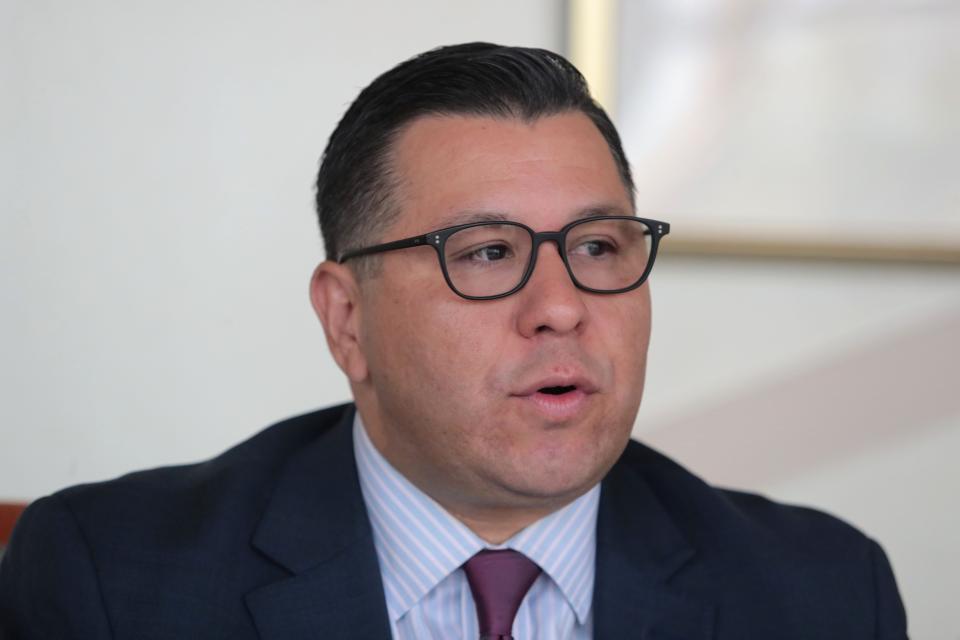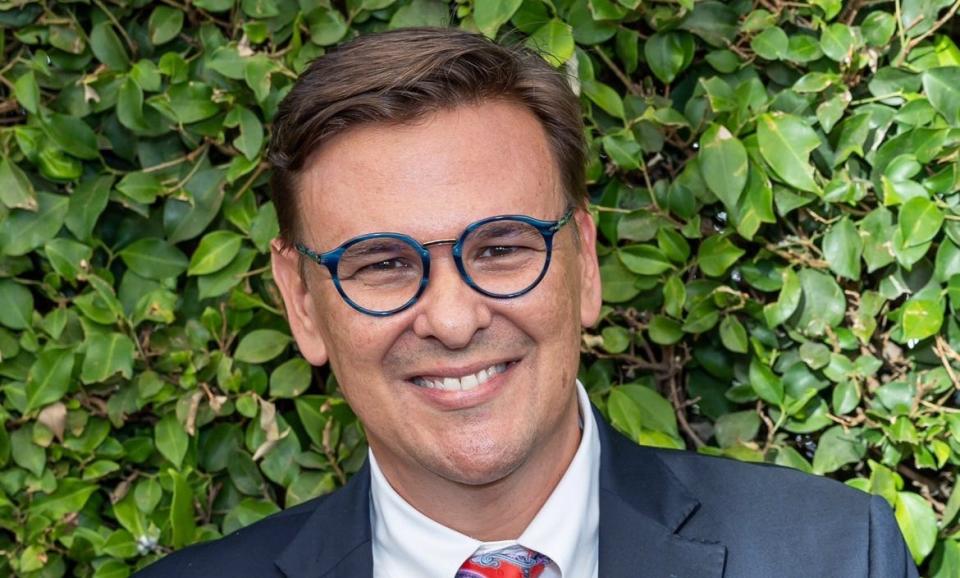Seismic retrofit aid bill passes in Assembly; Desert Regional's upgrades increase to $222M
With Desert Regional Medical Center facing a $222 million bill for renovations to protect it from earthquakes, state lawmakers have advanced legislation that could see the state help pay for such "seismic retrofitting."
A bill introduced by Assemblymember Eduardo Garcia, D-Coachella, recently passed in the Assembly, giving public district hospitals hope that financial help could be on the horizon.
For years, California hospitals have been gearing up to make costly upgrades due to the Alquist Hospital Seismic Safety Act, or Senate Bill 1953, which was passed in 1995 in response to unexpected poor seismic performance of hospitals during the 1994 Northridge earthquake. California law mandates that all hospitals rebuild or retrofit by Jan. 1, 2030, and must remain fully functional in the event of an earthquake.
Garcia's Assembly Bill 869, co-introduced by Assemblymember Jim Wood, aims to provide public district hospitals, especially those in rural areas, with seismic safety compliance grant assistance, and allow for delays to meet seismic and other building standards depending on certain financial hardship conditions. If hospitals are not able to fund the retrofits or doing so would result in financial hardships, they could request a five-year extension that would push the compliance date to Jan. 1, 2035.
The bill passed unanimously in the Assembly on May 30 and is currently in the state Senate. It was referred to the Senate Committee on Health.

Last year, Garcia sought to secure a $1 billion state budget appropriation in fiscal year 2022-23 in order to help public district hospitals meet the 2030 mandate, but it ultimately failed.
“We are deeply concerned about the seismic compliance burden placed on our hospitals. With a coalition of my colleagues whose districts are experiencing similar challenges, we have been advancing policy solutions to extend urgent relief," Garcia said in a statement. "AB 869 would delay requirements, allowing additional time for resources to be made available to assist with compliance. We have been actively engaged in these conversations to ensure that district hospitals in need can be eligible for relief.”
Health care and hospital districts are special districts that are independent from city or county governments and typically serve rural, low-income areas that do not have ample access to medical care, according to the California Healthcare Foundation. Of the 76 healthcare districts in the state, 54 serve rural areas.
"Many hospitals throughout rural, underserved areas are struggling to keep their doors open, let alone meet the seismic mandate," Garcia said in a statement. "We are focusing our legislative attention on this urgent matter to provide critical relief and resources to ensure the delivery of quality medical care and protect our district’s healthcare future."
The Desert Healthcare District and Foundation serves 443,239 residents in the Coachella Valley, based on 2020 Census data. Desert Regional Medical Center in Palm Springs is owned by the district, while Tenet Healthcare operates the hospital.
Originally, the district estimated the cost to meet retrofit requirements at Desert Regional between $119 million and $180 million, which includes estimates of soft costs associated with professional fees, inspection and other items. However, due to inflation and rising costs, the updated estimate is now $222 million.
District and Foundation CEO Dr. Conrado Bárzaga said he is "elated" that the bill has moved forward in Assembly and is confident it will be passed as law.
"The Legislature understands that these are public hospitals and that we don't have the deep pockets to do a seismic retrofit, that this is an unfunded mandate, and that we all need to identify solutions to preserve the health care infrastructure of the state of California," Bárzaga said.
What upgrades are needed?
Structural seismic retrofits are needed at three buildings — the main hospital and additions, east tower and north wing — and nonstructural retrofits at 20 buildings at Desert Regional's campus, according to an updated 2022 report from engineering firm Simpson Gumpertz & Heger Inc.
In the main hospital, retrofit options include thickening deficient walls and replacing steel-braced frames with reinforced concrete walls. The engineering company identified deficiencies in the east tower with chord and collector connections, frame beams and connections and foundations. Similarly, there are issues between beams and walls in the north wing.
In 2018, cost estimates for structural retrofits at these three sites totaled nearly $93 million. The 2022 estimated cost, which includes normal extra contractor general conditions, general requirements, insurance, fees, 10% contingency and 21% escalation, is now nearly $117.4 million.
Nonstructural retrofit efforts that need to be made include upgrading fire sprinkler systems in a few buildings and ceiling and wall retrofits, among others. Evaluation reports will need to be completed for several of the older buildings on the Desert Regional campus.

Bárzaga anticipates costs will continue to grow due to inflation, making AB 869 even more important.
"The Legislature a few years ago threw a blanket requirement for everyone to do a seismic retrofit without taking into consideration that not all hospitals are the same," Bárzaga said. "Now, we have a large number of public hospitals that might be at risk of closing if they cannot do a seismic retrofit, if they cannot comply with the law, unless we modify the law."
Both Community Medical Center Long Beach and Pacific Alliance Medical Center, the oldest hospital in Los Angeles, closed their doors in recent years because of costs associated with seismic retrofits, according to the Los Angeles Business Journal. That led to hundreds of employee layoffs, as well as thousands of residents losing health care access.
"Closures of those public hospitals would reverberate across the state," Bárzaga said. "It would be really significant to see so many hospitals closing their doors ... that would have a huge impact, especially on populations that are insured by Medi-Cal."
At this time, there is no concern that the Palm Springs hospital will close due to an inability to fund upgrades, the CEO said.
"We're confident that we will help pass this law and that we will find a feasible solution to persevere our hospital. I know the Legislature is concerned with this, so it's very likely that we will find the legislative support that we need," Bárzaga said. "We will continue to work hand-in-hand with Tenet to ensure that this hospital is open and continues to provide the health care services that our community in the Coachella Valley need."
Other area hospitals
Nonpublic hospitals in the desert do not depend on taxpayer money or government funds to complete seismic retrofits.
In 2015, through donations by Dennis and Phyllis Washington and other Eisenhower Health donors, the Rancho Mirage hospital began the process of seismically retrofitting its original hospital building. There were also projects done at the Walter and Leonore Annenberg Pavilion, which addressed bed replacement in response to seismic requirements, and the emergency department and Renker Pavilion, which included some seismic retrofits, spokesperson Lee Rice said. The total cost of the projects was $300 million.
Rice said Eisenhower Health met 2020 requirements of SB 1953 — which involved retrofitting the highest risk buildings by 2020 — nearly two years ahead of schedule.
"The main hospital building was retrofitted to meet the requirements and will remain an inpatient services building until 2030," Lee said in a statement. "All beds have been removed from the building and only a handful of other services remain that will be moved to other parts of the hospital by 2030. The main hospital building would continue as an outpatient services building post 2030."
If the 2030 deadline for the main building, also known as the Dennis and Phyllis Washington building, is not extended, Eisenhower Health will not be able to use 57 beds remaining in the building for acute care services, she said in a statement. Additionally, the Cardiovascular Pavilion, which is a component of the Cardiovascular Institute, is directly related to meeting the 2030 deadline and relocating critical services from the Washington Building to other parts of the hospital. The cost of the pavilion will be approximately $70 million.
Assessment and design work for nonstructural retrofits is in progress. This work needs to be completed by 2030 and has not been priced yet, Rice said.
Desert Care Network spokesperson Richard Ramhoff said in a statement: "Hi-Desert Medical Center has met the 2030 seismic requirements from the State of California. JFK Memorial Hospital meets all current seismic standards and we remain committed to meeting future requirements."
Ema Sasic covers entertainment and health in the Coachella Valley. Reach her at ema.sasic@desertsun.com or on Twitter @ema_sasic.
This article originally appeared on Palm Springs Desert Sun: Eduardo Garcia's seismic retrofit aid bill passes California Assembly

